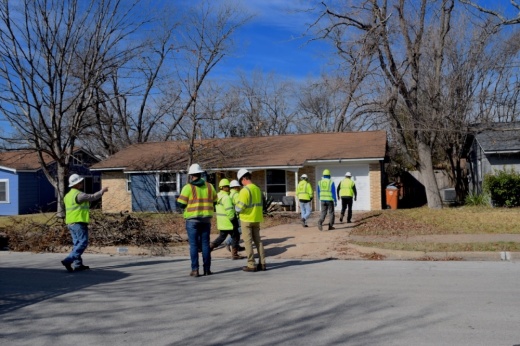The news came during a 3 p.m. press conference on Feb. 4
As of the press conference, the outage map shows about 13% of customers without power. Some customers lost their power at the beginning of the ice storm and are on day five without power, Mayor Pro Tem Paige Ellis said.
"I share your frustration about these unknown timelines, especially when outage reporting tools are sometimes not accurately reflecting your situation in real time," Ellis said. "And long phone call wait times put people in a position of using their limited cell phone battery to make sure that crews know their current condition."
Austin Energy General Manager Jackie Sargent said more than 62,000 customers have had their power restored since 5 p.m. Feb. 3, with a total of 267,000 restorations since the storm started. As of the press conference, she said there was about 1,700 outages affecting approximately 68,000 customers.
Many of remaining repairs are complex and time intensive, said Elton Richards, Austin Energy vice president of field operations.
Some of the remaining outages stem from hard to access lines and equipment, such those as around green belts, and lines that have been significantly impacted, similar to a section of lines that were taken out by a toppled communication tower, the Austin Energy representatives said.
"This storm is ungodly," Richards said. "I've never seen it in my life. And like I said, I worked in the northern part of Illinois, never saw this level of devastation."
About 400 crew members from Austin Energy and neighboring utilities are working on repairs, but there is no estimate for total system restoration, Sargent and Richards said.
"I understand the frustration. Believe me, my crews are frustrated," Richards said. "They want your power on. They'd like to go back home to their families instead of living in hotels and working 16 hours a day."
Roads and resource recovery
Austin Resource Recovery has caught up with services that were missed during the storm and will resume its normal schedule, Austin Resource Recovery deputy director Richard McCann said.
Previously scheduled brush collections will continue, McCann said, and there will be city-wide brush pick-up efforts.
"I think the key point I want to get across is even if we don't get to you on the first round—if you still haven't gotten your material out front—don't worry," McCann said. "We're going to be back. We're going be making multiple sweeps of the city. So if we don't get you on the first pass, we will get you on those subsequent passes."
Residents can take their brush to Hornsby Bend Biosolids Management Plant at 2210 FM 973, Austin, McCann said, and the department is working on additional drop off facilities in North and South Austin that could be up and running as soon as Feb. 6.
This city has activated a website with information about debris clean up, including resources for residents. McCann said the department will create an online map so customers can track clean up efforts.
McCann said in the first three days of Winter Storm Uri in 2021, the department had 307 service requests. For this storm, the department had about 3,000 orders in the same time frame. He said half of those orders are from council districts 6, 8 and 10.
James Snow, deputy director of the Public Works Department, said 29 crews are working around the city to clean up debris on the roads.
Snow said the department has had more than 1,500 request for services related to the roads, of which 90% are to clear debris in the right-of-way. He said 748 requests have been fulfilled and there are more than 500 requests remaining.
Starting Feb. 7, crews will scour the city in a grid method to catalog the work that needs to be done for storm clean up, Snow said.
Snow said 54 traffic signals remain down as of 3 p.m. Feb. 4 and nine are flickering. The flickering signals should be restored by the end of the day, while the others are dependent on power restoration.





